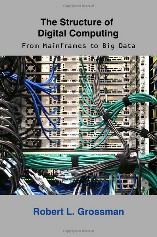News
January 2, 2015. There is now a pdf version of Structure of Digital Computing that you can download.
December 10, 2014. The Structure of Digital Computing is part of Kindle Unlimited, so that you can read the Amazon Kindle version for free if you are a member of this program.
February 18, 2013. The Kindle version of Structure was just published.
Reviews
"An intriguing study of data and how it has evolved, 'The Structure of Digital Computing' is well worth considering, highly recommended."
The Midwest Book Review
"Fascinating insights into the past, present and future of computing."
Kirkus Reviews
"If you have ever wondered whether there is any structure beneath all the noise in the marketplace about computing, this is the book to read."
Stuart Bailey, Founder and CTO of Infoblox
"Reading this book will help you understand the basic concepts and trends that have shaped computing for the past half century and that will continue to do so for the forseeable future."
Joel J. Mambretti, Director of the International Center for Advanced Internet Research at Northwestern University
Learn About Big Data
Chapter 5 of Structure of Digial Computing provides a quick introduction to big data that some people have found helpful. This chapter can be read independently of the others.
Learn About the Internet of Things
Chapter 1 describes five eras of computing, beginning with the Mainframe Era and ending with the Device Era, or what is now being called the Internet of Things (IoT). This Chapter may also be read independently of the others if you would like a quick introduction to how we are transitioning from the web to the IoT.
A "Long View" Perspective on Computing
After reading the Structure of Digital Computing, you will learn the answers to the following questions:
How would you explain the last 50 years of computing if you had only 90 seconds? (Chapter 1)
What is commoditization and why is it so important to understanding computing trends? (Chapter 2)
How can you distinguish important technical advances in computing from market clutter? (Chapter 3)
Do new computing technologies generally take 1 year, 2 years, 5 years, 10 years, or longer to develop? (Chapter 4)
What is big data? (Chapter 5)
The Structure of Digital Computing takes a 50 year perspective on the history of computing and divides this period into five overlapping eras: mainframe computers, personal computers, the web, and clouds of devices. The book argues that most of what vendors try to pass off as revolutionary is simply market clutter. It also argues that genuine technical innovations are rare and hard to predict, but are usually recognized and appreciated quite quickly.
From the book's perspective, we are transitioning from the third era of computing (the web) to the fourth era of computing, the era of computing devices. In the device era, many of us will replace our desktop and laptop computers with digital devices, such as smart phones and, in the shortly, wearable computers. The Internet of Things (IoT) is another term that is used to describe this era.
These devices (large and small) are all producing data and this is leading us into the fifth of computing: the era of big data.
The book has five chapters:
- The Five Eras of Computing
- Commoditization: Beyond Moore's Law
- Technical Innovation vs Market Clutter
- Technology Adoption Cycles
- The Era of Data
The first chapter is an overview of the first four eras of computing. Chapter 2 is about commoiditization (the process which gives less expensive and more powerful computer chips each year) and its impact. Chapter 3 looks at some of the roots of technology innovation and market clutter. Chapter 4 explains why it usually takes at least a decade for us to adopt a new technology. The last chapter is a gentle introduction to the era of big data.
Here is the table of contents.

